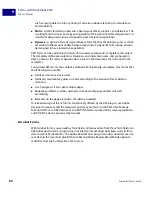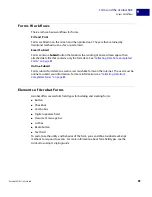
Providing Document Security
Encryption and Decryption
11
92
Acrobat SDK User’s Guide
Encryption and Decryption
Encryption is controlled by an
encryption dictionary
in the PDF file. Acrobat uses RC4 (a
proprietary algorithm provided by RSA Data Security, Inc.) to encrypt document data, and a
standard (proprietary) method to encrypt, decrypt, and verify user passwords to determine
whether or not a user is authorized to open a document. See Section 3.5, “Encryption,” in
the
PDF Reference
for more information on the encryption used in PDF files.
Each stream or string object in a PDF file is individually encrypted. This level of encryption
improves performance because objects can be individually decrypted as needed rather
than decrypting an entire file. All objects, except for the encryption dictionary (which
contains the security handler’s private data), are encrypted using the RC4 algorithm that
Adobe licenses from RSA Data Security, Inc. Plug-ins may not substitute another encryption
scheme for RC4.
For digital signatures and document encryption, Acrobat supports public-key
cryptography. Public-key cryptography uses two keys: a public key, which is stored inside a
certificate that can be shared with other users, and a private key, called a digital ID, which is
not shared with others. The public key certificate is used to encrypt (scramble) documents
or to verify digital signatures, and the digital ID is used to decrypt (unscramble) encrypted
documents or to create digital signatures.
Digital IDs and Certificates
A digital ID lets you create a digital signature or decrypt an encrypted PDF document. A
digital ID is sometimes referred to as a private key, a credential, or a profile.
When you sign or decrypt a document, you select which digital ID to use. A digital ID is
usually password-protected and can be stored on your computer as a PKCS#12 file, on a
smart card, or in the Windows Credential Store. You can get a digital ID from a third-party
provider, or you can create a self-signed digital ID and share your signature information
with others using a public key certificate. A certificate is a confirmation of your digital ID
and contains information used to protect data.
When a digital signature is applied, a unique fingerprint with encrypted numbers is
embedded in the document. The recipient needs the signer’s certificate to validate that the
Adobe Policy Server
Apply server-based security policies to PDF documents.
Server-based security policies are especially useful if you want
others to have access to PDF documents only for a limited
time. See
“Security Policies” on page 97
.
Document certification
When an author digital signature is added, editing changes are
restricted and detected. See
“Certifying PDF Documents” on
page 97
.
Summary of Contents for Acrobat 7.0.5
Page 10: ...Contents 10 Acrobat SDK User s Guide ...
Page 66: ...Modifying the User Interface Customizing Acrobat Help 6 66 Acrobat SDK User s Guide ...
Page 78: ...XML and the Acrobat SDK Managing XML based Information 8 78 Acrobat SDK User s Guide ...
Page 100: ...Providing Document Security Document Rights 11 100 Acrobat SDK User s Guide ...
Page 106: ...Working with Metadata Object Data 12 106 Acrobat SDK User s Guide ...
Page 110: ...Searching and Indexing Indexing PDF Documents 13 110 Acrobat SDK User s Guide ...
Page 118: ...Working With PDF Layers Working with Layers from a Plug in 15 118 Acrobat SDK User s Guide ...
















































